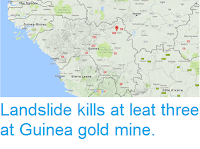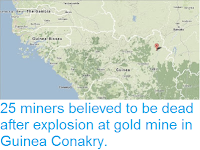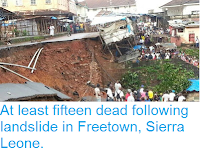As many as forty miners are feared to have died following a collapse at a gold mine in Nimba County, Liberia, on Saturday 9 February 2019. About sixty miners were bellow ground when the incident happened at the Gbanepea Gold Mine near Tappita. Twenty of the miners were able to escape the scene, and five bodies have been recovered, but the fate of the remaining miners is unclear, and local residents are asking the government for aid in mounting a rescue attempt.
Miners outside a tunnel at the Gbanepea Gold Mine in Nimba County, Liberia. Liberia Dispatch.
The Gabanepea Gold Mine was first opened as an open pit mine in the 1930s, but abandoned during the Liberian Civil War (1989-1997). Artisanal miners using traditional tools began to excavate at the site in September last year, resulting in a series of landslips, prompting authorities to intervene and close the site. However since then miners have apparently dug a series of deep holes into the sides of the pit, reaching as far as 200 m from the surface, an operation which appears to have been successful until this week's collapse.
Artisanal mining is widespread in eastern Liberia and Sierra Leone. It is often
referred to as 'illicit', though in an area with little formal
employment this is somewhat unfair, with local people viewing small
scale mining as a traditional way of gaining some hard cash. The area is
covered by poorly consolidated alluvial (river) sediments, washed out
from the mineral rich Fouta Djallon Highlands, in neighbouring Guinea,
since the last ice age. These loose sediments can be excavated and
panned to produce small amounts of gold and diamonds. This can be a
dangerous task, as sediments close to the surface are likely to have
been worked by previous generations of villagers, requiring deeper pits
to be dug into the often waterlogged sediments, with the accompanying
risk of pit collapses.
See also...
Follow Sciency Thoughts on Facebook.







